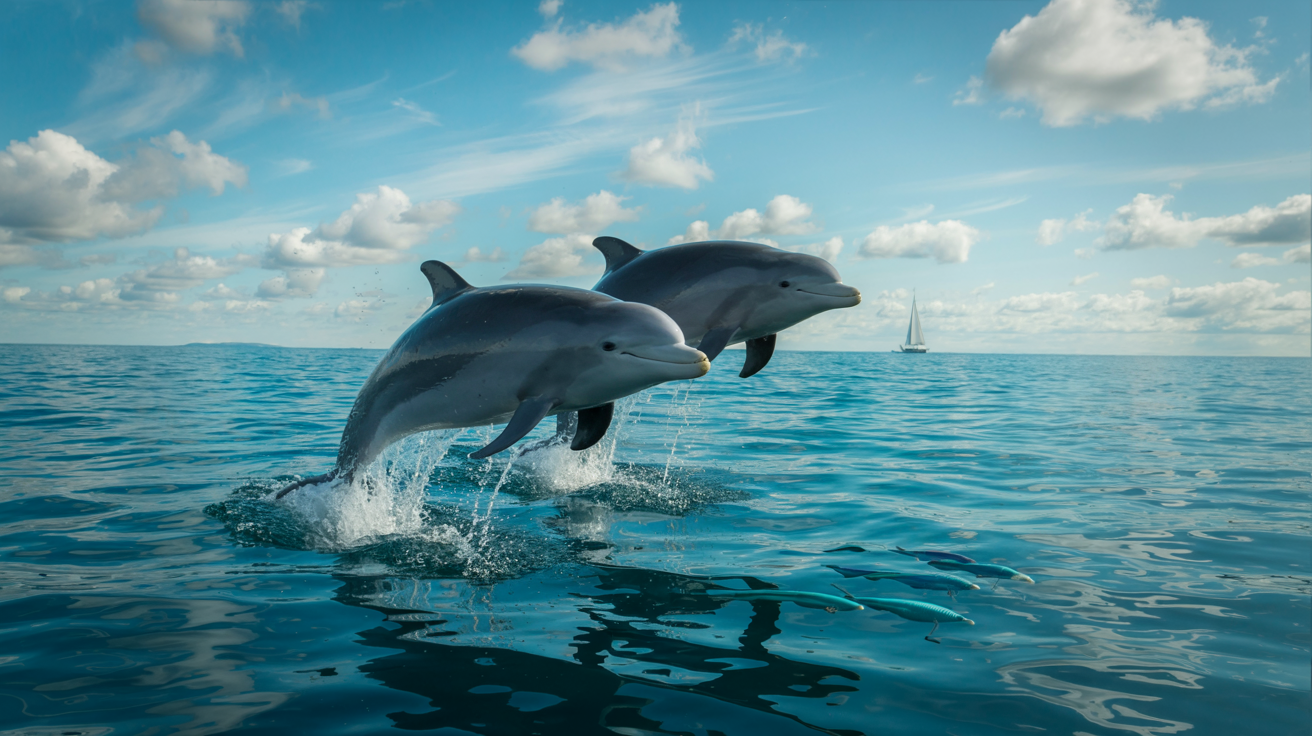Did you know dolphins can recognize themselves in a mirror? This puts these ocean mammals in an elite club of self-aware animals alongside humans and great apes.
Many people think they know dolphins from shows and movies. But the real lives of these ocean residents contain facts that are far more interesting than fiction.
These smart swimmers have complex social lives, remarkable communication skills, and problem-solving abilities that scientists are still working to understand fully.
This collection of fun facts about dolphins will take you below the surface to see why these mammals have amazed humans across cultures for centuries.
Ready to meet the true masters of the sea on their terms?
What Makes Dolphins so Special?

Dolphins stand out in the animal world for several key reasons. Their brain size relative to body mass ranks second only to humans, showing remarkable intelligence.
They use a complex system of clicks, whistles, and body language to talk with each other. These social animals live in groups called pods where they hunt, play, and protect one another.
Dolphins also show empathy and can recognize themselves in mirrors, a rare trait in animals. They even sleep with one half of their brain at a time, keeping the other half alert to watch for danger. These traits combine to make dolphins truly exceptional.
Wave-Worthy Fun Facts About Dolphins

Dolphins do more than just swim. They live lives full of surprising habits and abilities. These facts showcase why dolphins stand out from all other sea creatures.
Let’s swim through some of the most interesting things you might not know about these smart marine mammals.
1. Dolphins are marine mammals, not fish.
Often mistaken for fish, dolphins are actually mammals in the cetacean family. Unlike fish, dolphins are warm-blooded, breathe air, and nurse their young.
2. Dolphins breathe air through a blowhole on top of their heads.
Rather than breathing through their mouths like humans, dolphins have a blowhole on top of their heads that they use to breathe.
This allows them to take quick breaths without needing to fully surface, helping them stay agile and alert while swimming.
3. Dolphins can hold their breath for up to 15 minutes.
Dolphins are exceptional breath-holders. While most will surface for air every few minutes, they can hold their breath for as long as 15 minutes when necessary.
This incredible ability allows them to dive deep in search of food or to avoid predators.
4. There are over 40 different species of dolphins.
Dolphins are incredibly diverse! With over 40 species spread across the globe, dolphins vary in size, shape, and habitat.
From the well-known bottlenose dolphins to the elusive pink river dolphins of the Amazon, each species has unique features that help them thrive in their environments.
5. Dolphins are highly intelligent and social creatures.
Dolphins are often compared to apes in terms of intelligence. They form complex social groups called pods and communicate with each other using a variety of sounds.
Their ability to learn, problem-solve, and work together shows just how advanced their minds are.
6. Bottlenose dolphins are the most well-known species.
Thanks to their friendly appearance and appearances in movies and aquariums, bottlenose dolphins are the most famous.
Known for their playful nature and curious behavior, bottlenose dolphins have become the poster animals for dolphins everywhere.
7. Dolphins use echolocation to hunt and navigate.
Dolphins have a built-in sonar system called echolocation. They send out sound waves that bounce off objects, helping them “see” their surroundings even in dark or murky waters. This skill is essential for hunting and avoiding obstacles.
8. Their brains are larger than those of humans.
Dolphins’ brains are impressive; not only are they larger than humans’ relative to their body size, but they’re also highly complex.
The parts of their brain responsible for communication, emotions, and social interactions are especially well-developed, which contributes to their advanced social skills.
9. Dolphins communicate using clicks, whistles, and body movements.
Dolphins have an impressive communication system. They share information using a variety of sounds, from high-pitched whistles to clicking noises.
They also communicate using body language, ensuring everyone in the pod stays in sync.
10. Dolphins sleep with one eye open.
To stay alert to threats while resting, dolphins sleep with one half of their brain at a time. This allows them to keep one eye open and remain aware of their surroundings, while still getting the rest they need to stay healthy.
11. Dolphins are known to help injured or sick pod members.
Dolphins are remarkably caring animals. If a member of their pod is injured or sick, dolphins will often help them by supporting them at the surface so they can breathe. This empathy highlights the strong bonds and loyalty within dolphin groups.
12. They often ride waves and even surf.
Dolphins are natural wave riders. They often enjoy the thrill of surfing on ocean waves or riding the wake behind boats. These playful behaviors are not just fun; they also show off dolphins’ curiosity and love for the water.
13. Dolphins have excellent eyesight both above and below water.
Dolphins’ eyes are perfectly adapted for both water and air. They can see well in murky underwater conditions and can also focus on objects above the surface. This sharp vision helps them spot prey, navigate, and communicate with pod members.
14. A dolphin’s skin regenerates every two hours.
Dolphins have a unique ability to regenerate their skin every two hours, keeping it smooth and sleek. This rapid skin turnover reduces drag in the water, making it easier for dolphins to swim at high speeds without getting slowed down.
15. They are known to play with seaweed and other objects.
Dolphins are playful by nature and love to interact with their environment. They’ve been seen playing with seaweed, tossing it around, or even using it in games with other dolphins. Their playful behavior is an indication of their intelligence and curiosity.
16. Dolphins can swim up to 25 miles per hour.
Dolphins are fast swimmers! They can reach speeds of up to 25 miles per hour, thanks to their streamlined bodies and powerful tails. This speed helps them escape predators and catch fast-moving prey in the wild.
17. Some dolphins live in freshwater rivers like the Amazon.
Not all dolphins live in the ocean! Some species, like the Amazon river dolphin, thrive in freshwater environments.
These dolphins have adapted to life in murky rivers and even have flexible necks to help them navigate through flooded forests and shallow waters.
Other Amazing Fun Facts About Dolphins
-
Dolphins are warm-blooded animals.
-
They can jump up to 20 feet in the air.
-
Dolphins have signature whistles to identify themselves.
-
They can mimic human voices.
-
Dolphins often form lifelong bonds with other dolphins.
-
They use teamwork to herd fish during hunting.
-
Dolphins have two stomachs – one for storage and one for digestion.
-
They are often seen leaping in front of boats.
-
Dolphins can detect underwater mines for the navy.
-
Some dolphins have been trained to rescue swimmers.
-
They sometimes cooperate with fishermen to catch fish.
-
Dolphins are part of the cetacean family, like whales.
-
The orca, or killer whale, is the largest dolphin species.
-
Dolphins can live for 40 to 60 years in the wild.
-
They have been observed mourning their dead.
-
Dolphin skin is smooth and feels rubbery.
-
Dolphins shed their outer skin frequently to reduce drag.
-
Male dolphins are called bulls; females are cows; babies are calves.
-
Dolphins rarely have twins.
-
A dolphin pregnancy lasts around 12 months.
-
Calves are born tail-first to prevent drowning.
-
Dolphins teach their young how to hunt.
-
Dolphins can swim backward.
-
They can hear frequencies 10 times above the human range.
-
Dolphins can make up to 1,000 clicking sounds per second.
-
They use their teeth to catch fish but don’t chew them.
-
Dolphins swallow their food whole.
-
Dolphins have about 80-100 conical teeth.
-
They don’t have a sense of smell.
-
Dolphins’ dorsal fins are unique like fingerprints.
-
Their flukes help them steer and stop.
-
Dolphins breathe voluntarily, unlike humans.
-
Dolphins have been seen using tools, like sponges to protect their snouts.
-
They are capable of empathy.
-
Dolphins can remember sounds for more than 20 years.
-
Their playful nature includes playing tag.
-
Dolphins can get sunburned if exposed too long.
-
Some species can dive over 1,000 feet deep.
-
Dolphins help other species in distress.
-
They can suffer from stress and depression.
-
Dolphins have excellent memory recall.
-
They can imitate the behaviors of other species.
-
Dolphins have been observed saving humans from sharks.
-
They are one of the few animals that can understand pointing.
-
Some dolphins display homosexual behavior.
-
Dolphins sleep with half their brain active.
-
They surface for air roughly every 5 to 8 minutes.
-
Dolphins don’t drink seawater; they get moisture from food.
-
Their bodies are streamlined for fast swimming.
-
Dolphins use bubble rings for play and communication.
-
Males sometimes present gifts to females during mating.
-
They use complex vocalizations to form social groups.
-
Dolphins are found in all oceans except the polar regions.
-
Some dolphins can survive in brackish waters.
-
Dolphins use their tails to launch themselves into the air.
-
They can “see” with sound through echolocation.
-
Dolphins can coordinate with others to create fish traps.
-
They’re known to “spy hop” to see above the water.
-
Dolphins often rub against each other for bonding.
-
They can be right- or left-sided like humans.
-
Dolphins can whistle continuously for minutes.
-
Some dolphins slap the water with their tails in anger.
-
Their hearts beat slower when they dive.
-
Dolphins can detect metal objects underwater.
-
They sometimes play with turtles or jellyfish.
-
Dolphins are curious and often approach boats.
-
Some dolphins have been seen using medicinal plants.
-
They sometimes engage in synchronized swimming.
-
Dolphins can “see” behind them using sound waves.
-
Dolphins can produce two sounds simultaneously.
-
Their tail muscles are extremely powerful.
-
They don’t chew because their jaws can’t move side to side.
-
Dolphins’ body language includes jaw claps and postures.
-
They are capable of mimicry and play-fighting.
-
They understand abstract concepts like zero.
-
Dolphins can make individual decisions independent of the group.
-
Some cultures consider dolphins sacred.
-
Dolphins are frequently featured in myths and legends.
-
Ancient Greeks believed dolphins brought good luck.
-
Dolphins often live in matriarchal pods.
-
They use “baby talk” with their calves.
-
Dolphins have no vocal cords; sounds come from nasal sacs.
-
They can tolerate saltwater due to special kidney functions.
-
Dolphins don’t have hair, except a few whiskers at birth.
-
Dolphins’ lungs are more efficient than humans’.
-
They can exhale and inhale in less than a second.
-
Dolphins use their pectoral fins to hug.
-
Their brains have more folds than human brains.
-
Dolphins are capable of complex problem-solving.
-
Some dolphins use mud circles to trap fish.
-
They can adapt their sounds to noisy environments.
-
Dolphins have cultural behaviors passed across generations.
-
Dolphins don’t have external ears.
-
They use time-distance perception for hunting.
-
Dolphins are fast learners.
-
They can distinguish between different shapes and colors.
-
Dolphins play games like “pass the object.”
-
Some dolphins have scars from encounters with predators.
-
Dolphins help injured pod members reach the surface.
-
Dolphins can leap as high as 30 feet.
-
Dolphins can learn sign language.
-
They often chase each other for fun.
-
Dolphins can remember names.
-
Some dolphins sleep near the surface and bob like logs.
-
Dolphins use vocal mimicry to bond.
-
Dolphins can modify their whistles over time.
-
They prefer familiar individuals over strangers.
-
Dolphins have been known to grieve.
-
They enjoy playing with bubbles.
-
Dolphins have been observed teaching.
-
Dolphins learn by watching others.
-
They sometimes play with humans just for fun.
-
Dolphins coordinate to protect their calves from predators.
-
Some dolphins specialize in hunting techniques.
-
They display self-awareness in mirror tests.
-
Dolphins can track objects using echolocation.
-
Dolphins can control their heart rate while diving.
-
Dolphins enjoy rubbing on rough surfaces for a massage.
-
They help each other give birth.
-
Dolphins can understand syntax in communication.
-
Dolphins whistle more when separated from friends.
-
Some dolphins have regional accents.
-
Dolphins prefer certain types of fish.
-
Dolphins often accompany whales.
-
They perform acrobatic tricks in the wild.
-
Dolphins can diagnose pregnancies using echolocation.
-
They may avoid loud boat engines.
-
Dolphins learn tricks faster than dogs.
-
They rarely fight unless threatened.
-
Dolphins are sometimes trained as therapy animals.
-
Their heartbeat syncs with their movements.
-
Dolphins can sense electric fields.
-
Dolphins occasionally mimic human laughter.
-
Dolphins enjoy spinning in the air.
-
They sometimes “bow ride” for fun.
-
Dolphins recognize themselves in videos.
-
Some dolphins babysit others’ calves.
-
Dolphins have been known to invent games.
-
Their skin secretes antibacterial compounds.
-
Dolphins get ticklish in some spots.
-
They may sing in their own way.
-
Dolphins can sense vibrations through their lower jaw.
-
They help herd animals in danger.
-
Dolphins can communicate mood through sound.
-
Dolphins can sense underwater currents.
-
Dolphins sometimes work with other species to hunt.
-
Dolphins have been seen teasing other animals.
-
They adapt easily to new environments.
-
Dolphins have signature sounds like human names.
-
Some dolphins perform tricks naturally in the wild.
-
Dolphins are known to play with humans for hours.
-
Dolphins can mimic the sounds of other animals.
Dolphins and Humans: More Alike Than You Think!

Dolphins share surprising similarities with humans that go beyond their playful nature. They form strong social bonds that last for years and teach skills to their young, much like our family structures.
Their problem-solving abilities show a type of thinking that mirrors our own. We share several important traits that make our species more similar than different:
- Use tools to help them hunt and get food
- Have names for each other through signature whistles
- Play for fun, not just for learning
- Show signs of culture that pass through generations
- Feel emotions like joy, grief, and frustration
- Work together to solve problems and catch food
Wrapping Up the Waves
After learning these fun facts about dolphins, it’s clear why these animals hold such a special place in human hearts. Their intelligence, social structure, and playful nature make them truly unique in the animal kingdom.
These facts matter because they help us understand why dolphins need our protection. As we learn more about their complex lives, we see they’re not so different from us in many ways.
What should you do with this dolphin wisdom? Share it with friends, support marine conservation efforts, or plan a responsible dolphin-watching trip to see these remarkable animals in their natural habitat.
The more we know about dolphins, the better equipped we are to ensure they continue swimming in our oceans for generations to come.
Have you ever had a special encounter with dolphins? Or do you know another interesting fact about them? Share your stories in the comments below!
















